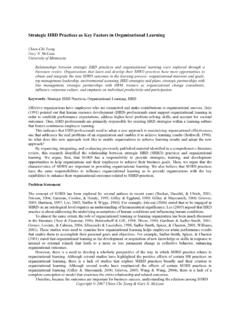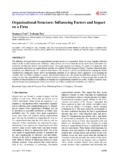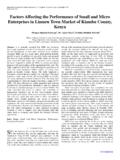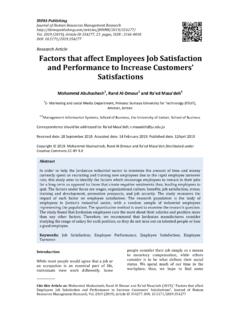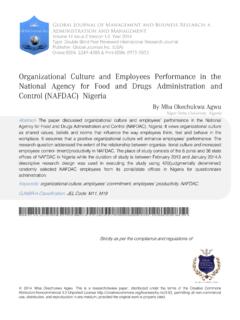Transcription of Organizational and environmental factors that affect ...
1 93 This article reviews Organizational factors that havebeen shown to influence the satisfaction, health,safety, and well-being of health care workers andultimately, the satisfaction, safety, and quality ofcare for patients. The impact of the work environ-ment on working conditions and the effects onhealth care workers and patients are also addressed. Although this review of these issues cannot be all-inclusive, it provides information that may be usedto enhance patient safety programs, including strate-gies that have been shown to affect quality as well asthe bottom line. This understanding of the complex-ity and magnitude of changes required to positivelyaffect workers, their environment, and patient out-comes will help set future research priorities in areaswhere there are gaps in attention has been focused on patient safetyin recent years.
2 It has been noted that healthy workorganizations demonstrate both financial successand a healthy workforce1 a fact recognized bymany purchasers of health care services. Purchasersare beginning to use this type of data to make con-tracting decisions. For example, The LeapFrogGroup, a consortium of Fortune 500 companies andlarge purchasers of health care services (eg, GeneralElectric, General Motors), requires providers toimplement evidence-based quality and safety prac-tices, including use of computerized physician orderentry, referrals to hospitals that handle a specifiedvolume of certain procedures, and management ofintensive care units (ICUs) by physicians certified (oreligible) in critical care HEALTH AND SAFETY:EFFECT OF THE ORGANIZATIONAND THE WORK ENVIRONMENTB ackgroundA wealth of literature exists on how health care work-ers experience job- and work-environment relatedstressors that adversely affect their safety andhealth.
3 Studies have identified many stressors,including role ambiguity, role conflict, heavy work- Organizational and environmentalfactors that affect worker healthand safety and patient outcomesTammy Lundstrom, MDaGina Pugliese, RN, MSbJudene Bartley, MS, MPH, CICbJack Cox, MD,bCarol Guither, BA, MSb,cDetroit, Michigan, and Oakbrook, IllinoisThis article reviews Organizational factors that influence the satisfaction, health, safety, and well-being of health care work-ers and ultimately, the satisfaction, safety, and quality of care for patients. The impact of the work environment on workingconditions and the effects on health care workers and patients are also addressed. Studies focusing on worker health andsafety concerns affected by the organization and the physical work environment provide evidence of direct positive and/oradverse effects on performance and suggest indirect effects on the quality of patient care.
4 The strongest links between work-er and patient outcomes are demonstrated in literature on nosocomial transmission of infections. Transmission of infectionsfrom worker to patient and from patient to patient via health care worker has been well documented in clinical on outbreaks of infectious diseases in health care settings has linked the physical environment with adversepatient and worker outcomes. An increasing number of studies are looking at the relationship between improvement in orga-nizational factors and measurable and positive change in patient outcomes. Characteristics of selected magnet hospitals arereviewed as one model for improving patient and worker outcomes. (Am J Infect Control 2002;30:93-106.)From the Detroit Medical Center,Wayne State University, Detroit, Micha;Safety Institute, Premier Inc, Oak Brook, Illb.
5 And General Motors, MIKAS ystems, requests: Gina Pugliese, RN, MS, Safety Institute, Premier Inc, 700 Commerce Dr, Suite 100, Oakbrook IL 2002 by the Association for Professionals in InfectionControl and Epidemiology, $ + 017/46/119820 , pressure, and physical has been shown to result in job dissatisfaction,burnout (physical, emotional, and mental exhaus-tion), staff turnover, occupational illness and injuries,reduced mental health, depression, and even , studies have also shown that the negativeimpact of these stressors can be reduced by factorssuch as a supportive social environment thatincludes coworkers and supervisors, peer and teamcohesion, autonomy, utilization of skills, rewards,and an emphasis on planning and in an organization with a strong and visiblecommitment to safety also has a positive impact onthe health and safety of ,9,10 Althoughempirical evidence is lacking, studies suggest work-er attitudes, job satisfaction, and employee healthand well-being are related to work performance; pro-ductivity.
6 And ultimately, the quality of health climateThe safety climate is defined as shared perceptionsof workers regarding the level of safety of their 1 lists 6 Organizational dimen-sions that have been identified as part of the hospi-tal safety climate. Most important of these dimensions are manage-ment commitment and safety performance feedbackfrom managers and ,12-14A strong safe-ty climate is associated with positive attitudes amongworkers, which can influence the adoption of safebehaviors and practices15-17and help reduce acci-dents and ,18,19 Positive attitudes also influ-ence job satisfaction and needed for a positive safety climate is thefirst step in influencing worker and patient need to know that administration is con-cerned about their safety; supports their efforts.
7 Andwill use information on safety-related issues, prob-lems, and errors only to improve the system and notfor and job burnout Job burnout is believed to result from stress in ser-vice occupations such as those in the health careindustry and is believed to represent a uniqueresponse to frequent and intense client/patient with burnout report a variety ofsymptoms, including emotional exhaustion, deper-sonalization (feeling distant from others), and asense of diminished personal accomplishment. Experts have suggested that burnout results from avariety of stresses, including situations in which workdemands cannot be met because of a lack ofresources such as social support from coworkers andsupervisors, job control, participation in decision-making, utilization of skills, and reinforcements suchas and job burnout also are related tospecific demands of work, including overload, varia-tions in workload, role conflict, and role ,21-25 Workers who perceive a high level of stress andresulting job burnout have poor coping responses andlack of job satisfaction, which often erode commit-ment to the organization and lead to higher of coworker and supervisor support contributesto perceived stress and resulting ,27In onestudy of performance among nurses by Salyer.
8 25ahigher number of admissions to/discharges from apatient care unit in 24 hours had a negative impacton the self-rated quality of performance. Workload(number of emergency admissions), number ofdeaths on the ward, and number of menial tasksperformed contributed to medical residents percep-tion of being overwhelmed and increased the num-ber of reported minor medical ofpeer support, role ambiguity, and perceived stresswere associated with job dissatisfaction and depres-sion among a meta-analysis of 61 studies of job burnout, indi-viduals were more sensitive (ie, at greater risk ofemotional exhaustion) to demands of the job than toavailable resources. Lee and Ashforth2hypothesizedthat this sensitivity might be related to the ability toincrease resources and thus compensate for thework demands, whereas the emotional demands ofthe job remained studies have shown that job stress may be arisk factor for hypertension and increases in left ven-tricular mass index.
9 In physicians, job stress increas-es diastolic blood increase may berelated to inexperience because senior staff mem-bers had lower blood pressure elevations than theirjunior colleagues. Finally, shift work is a risk factor formyocardial infarction unrelated to smoking, jobstrain, or job education illnesses and injuries A number of studies have linked job stressors toincreased risk of work-related injuries and artery disease. Several studies, includ-ing the Framington Heart Study, have linked job94 Vol. 30 No. 2 Lundstrom et alApril 2002 95design factors and the organization of work toincreased risk of cardiovascular factors were minimal opportunities to learnnew things, hectic or monotonous work, and low lev-els of job control and social and Infeld37used multivariatelogistic regression analysis (controlling for personaland other work organization variables) to show thatworkers with low levels of job control had anincreased relative risk of cardiovascular diseasemortality ( ) compared with workers with higherlevels of control.
10 Individuals with combined low jobcontrol and poor social support from coworkers hadan even higher relative risk ( ) of cardiovasculardisease mortality compared with workers with highjob control and social support. Conversely, high lev-els of job control were found to be protective againstcardiovascular disease disorders. A National Instituteof Occupational Safety and Health report38found anumber of work-related factors to be associatedwith upper-extremity musculoskeletal included work pressure, high work demands,surges in work loads, lack of job diversity, little deci-sion-making opportunity, fear of being replaced bycomputers, and lack of coworker support. Otherstudies have confirmed that the combination of highwork pressure, low task control, fear of job loss, orlack of promotion contributes to increased reportsof stress and related musculoskeletal pathogen exposures.





